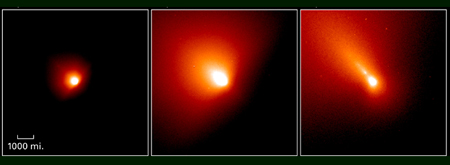CXC Home | Search | Help | Image Use Policy | Latest Images | Privacy | Accessibility | Glossary | Q&A
1
C/1999 S4: Hubble Optical
Images
From July 5 to 7, NASA's Hubble Space Telescope Imaging Spectrograph tracked comet C/1999 S4 (LINEAR). The first photograph (left) shows a dramatic increase in its brightness. The next image (middle) shows a wave of newly created dust from the outburst flowing into the atmosphere, or coma, of gas and dust around the comet's core. The image on the right, shows a chunk of material (bright dot behind comet) that broke off the nucleus and is trailing in the comets tail. For more information on the Hubble images.
(Credits: NASA, H.Weaver and P.Feldman (Johns Hopkins Univ.), M.A'Hearn (Univ. of Maryland), C.Arpigny (Liege Univ.), M.Combi (Univ. of Michigan), M.Festou (Obs. Midi-Pyrenees), and G.-P. Tozzi (Arcetri Obs.))
From July 5 to 7, NASA's Hubble Space Telescope Imaging Spectrograph tracked comet C/1999 S4 (LINEAR). The first photograph (left) shows a dramatic increase in its brightness. The next image (middle) shows a wave of newly created dust from the outburst flowing into the atmosphere, or coma, of gas and dust around the comet's core. The image on the right, shows a chunk of material (bright dot behind comet) that broke off the nucleus and is trailing in the comets tail. For more information on the Hubble images.
(Credits: NASA, H.Weaver and P.Feldman (Johns Hopkins Univ.), M.A'Hearn (Univ. of Maryland), C.Arpigny (Liege Univ.), M.Combi (Univ. of Michigan), M.Festou (Obs. Midi-Pyrenees), and G.-P. Tozzi (Arcetri Obs.))
2
Schematic showing comet LINEAR
orbit.
Comet LINEAR was discovered on September 27, 1999. Its closest approach to Earth occurred July 23, 2000 at a distance of 35 million miles. Its closest approach to the Sun occurred July 26, 2000 at a distance of 71 million miles. LINEAR is an acronym meaning Lincoln Near Earth Asteroid Research.
(Credit: Larry Koehn)
Comet LINEAR was discovered on September 27, 1999. Its closest approach to Earth occurred July 23, 2000 at a distance of 35 million miles. Its closest approach to the Sun occurred July 26, 2000 at a distance of 71 million miles. LINEAR is an acronym meaning Lincoln Near Earth Asteroid Research.
(Credit: Larry Koehn)
3
Updated Chandra Image of Comet
C/1999 S4
Chandra's image of Comet LINEAR (originally released in July 2000, see #4 below) has been updated to incorporate new data that brings out the faint extended emission around the comet and remove certain processing artifacts.
(Credit: NASA/SAO/C.Lisse, S.Wolk, et al.)
Chandra's image of Comet LINEAR (originally released in July 2000, see #4 below) has been updated to incorporate new data that brings out the faint extended emission around the comet and remove certain processing artifacts.
(Credit: NASA/SAO/C.Lisse, S.Wolk, et al.)
4
Original Chandra Image of Comet
C/1999 S4 From July 2000.
On July 14, 2000 the Chandra X-ray Observatory imaged the comet repeatedly for a total of 2 1/2 hours and detected X-rays from oxygen and nitrogen ions. The details of the X-ray emission, as recorded on ACIS, show that the X-rays are produced by collisions of ions racing away from the Sun (solar wind) with gas in the comet.
(Credit: NASA/SAO/C.Lisse, S.Wolk, et al.)
On July 14, 2000 the Chandra X-ray Observatory imaged the comet repeatedly for a total of 2 1/2 hours and detected X-rays from oxygen and nitrogen ions. The details of the X-ray emission, as recorded on ACIS, show that the X-rays are produced by collisions of ions racing away from the Sun (solar wind) with gas in the comet.
(Credit: NASA/SAO/C.Lisse, S.Wolk, et al.)
Return to Comet C/1999 S4 LINEAR (27 Jul 00)






